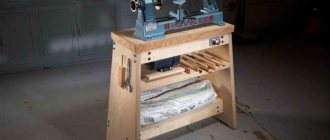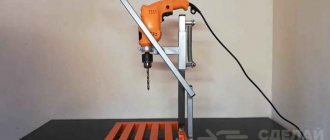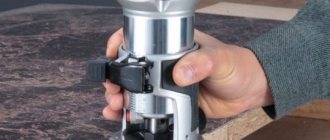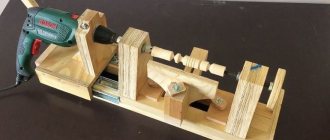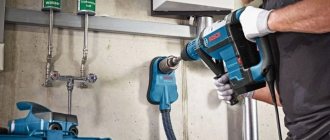Design features and device of the milling cutter
A milling cutter is a unit for processing wood or metal, designed primarily for cutting technological recesses. The device consists of a housing in which key components are located, a motor and a holder for installing collet adapters for cutters. At the bottom of the unit there is a platform made of cast or stamped metal.
When turned on, the electric motor of the milling cutter imparts rotation to the shaft and sets the milling attachment in motion. The tool allows you to make grooves and cavities in wood, process the edges of parts or create threads without wasting time and extra effort.
Classification
In accordance with the generally accepted classification, cutters of the shapes shown in the table are used for processing wood.
| Types of wood cutters | Main types of work |
| End | End surface processing |
| Cone-shaped | Processing any type of wood at different angles |
| V-shaped | Engraving, 45° chamfering and V-grooving |
| Disk | Making horizontal grooves of various sizes for cutting work |
| Profile | Decoration of products |
| Folded | Quarter milling |
| Mouldings | Rounding edges |
| bird home | Making tenon joints of various types |
| Curvy | Processing the edges of panel parts |
| Fillet | Creating fillets (grooves) on the edges of products |
There are various subspecies that differ in design, blade shape, and application.
Thus, using a ball (spherical or spherical with a round head) tool, you can perform artistic wood carving. There are special-purpose products used for cutting laminate flooring, furniture parts, handles, and handrails.
The combined type is a combination of a groove cutter and a tenon cutter, used for merging boards.
Plunge tools are used for milling grooves. To obtain neat grooves, models with an extended shank are produced.
Drawings of a router from a drill
If you plan to use the router frequently, you should purchase a ready-made device at a hardware store. But if a device is required to solve a specific problem, you can make it yourself from a conventional drilling unit.
If you have to process small workpieces with a milling machine, it is better to build a vertical machine
Drawings and photos of a do-it-yourself drill router show that the tools are very similar in design and operating principle. The difference is that the drilling device is designed to make pinholes and is not designed for radial loads.
When improving a drilling tool, it is important to install a collet chuck on it instead of a jaw chuck
The drill has a lower number of revolutions compared to the router. Even a converted tool should be used for working with soft workpieces.
Features of application
Of course, just installing a router from an electric drill is not enough - you need to properly care for it so that it functions for a long time. Experts make the following recommendations.
- All wood surfaces must not only be thoroughly sanded, but also treated with a protective coating in order to increase the ability to resist various adverse influences from the outside.
- The control system of the device should be carefully designed so that it is extremely comfortable.
- Certain additions can be made, such as a system for cleaning the work area from chips. For example, install a small pipe that you can connect to a hose from a simple vacuum cleaner.
What tools and materials will be needed
To make a router from a drill with your own hands, you need to prepare consumables. Their exact list depends on the chosen scheme, but usually you need to take:
- plywood or thin sheet of chipboard;
- metal clamp;
- nuts and bolts;
- self-tapping screws;
- jigsaw;
- feather or core drill;
- wrench;
- drills 0.4 and 0.8 cm;
- screwdriver
If you don't have a jigsaw, you can use a hacksaw as an alternative. If necessary, the screwdriver is replaced with a Phillips screwdriver.
Device Add-ons
There are several devices that can be added to make this device more convenient to use, as well as slightly expand its functionality. For example, you can add a device such as a microlift, which will move the drill in the vertical direction. If everything has become clear on how to make a wood router from a drill, then few people know how to make a microlift, and therefore here are brief instructions:
- Guides are required. You can use two metal rods as them.
- To fix the electric drill, you need to use a platform that will be made of the same plywood or chipboard.
- An element such as a threaded axle and a nut will be responsible for moving the electrical device in the vertical direction.
- It is necessary to use suitable devices that can hold the drill in the selected position.
How to make a manual wood router from a drill with your own hands
To make a simple hand router, you will need to take an electric drill, several wooden blocks and planks, and also screws and bolts. The tool creation algorithm looks like this:
- For the router, prepare a base from a thick board, two legs in the form of wooden blocks and two clamping device strips. The centers of future holes are marked on the structural elements. Holes for screws are made with a 4 mm drill. For holes in the corners of the clamping plates, use a 16 mm pen nozzle. For grooves for furniture bolts, you need a regular 6 mm drill.
The hole for the electric drill chuck is cut with a hole saw for wood with a diameter of 51 mm - Using a jigsaw, you cut out rectangular grooves in the clamping plates with your own hands, cut out the legs, and also make small recesses in the base for convenient holding of the structure.
All workpieces must be sanded with sandpaper, paying attention to sharp edges and corners - All parts are assembled together. First of all, using eight screws, screw one of the parts of the clamping device to the top of the base. After this, the legs are secured with four long screws. The second part of the clamp is secured with furniture bolts. Wing nuts with washers are screwed onto the ends of the fasteners.
A large number of fastenings ensures the clamping plates are securely fixed to the base - At the last stage, all that remains is to clamp a cylindrical cutter with the required offset in the electric drill chuck, insert the tool into the homemade device and secure the neck with wing nuts.
A simple manual milling cutter made from a drill is designed for drilling grooves with an average depth of 2-5 mm
When working with a router, you need to take into account that the grooves will be less neat than when using a purchased unit. But from the point of view of geometry, the recesses will be smooth.
Attention! It is not recommended to use a do-it-yourself router using a drill for processing especially hard wood, and especially metal.
Why do you need a drill on a magnetic bed?
When developing a drill on a magnetic bed, we were guided by the problem of creating holes in multi-ton metal structures that cannot be moved. Such trusses, like a large magnet, attract a pair with an opposite charge. Creating a charged frame for a drill solved the problem of securing a tool for drilling holes with high precision.
Drilling large cross-section holes in metal is carried out using different attachments, including using a milling cutter for a drill on a magnetic bed. Typically, this attachment is used in the form of a hollow crown. Drilling with a magnetic drill according to the markings is guaranteed to be accurate. As long as voltage is applied to the frame, the drill is held on the plane with a force of several tons per square centimeter. After turning off the current, the installation is easily moved to a new location; its weight does not exceed 25 kg.
A hole saw can be used to drill a hole in a structure up to 130 mm in diameter.
How to make a milling table from a drill
The milling table is the most convenient to use. When using it to make holes, you do not need to move the tool itself - it is in a fixed state. The diagram for making a simple table looks like this:
- The workbench lid is turned over and a large hole is cut using a jigsaw. In diameter it should be 5 mm larger than the dimensions of the cutter. A bar is installed perpendicular to the table - it must be positioned parallel to the long side. The part is secured with corners and screws.
The strip should be located exactly in the center of the prepared hole - At the bottom of the workbench cover, long screws are used to attach clamps for a drill, hand-cut from wooden blocks, to the surface. The design should allow you to freely adjust the position of the homemade router. It is also necessary to provide a movable clamp designed directly for fixing the power tool.
To adjust the position of the drill, screws with wing nuts are mounted in the clamps - To prevent sawdust from interfering with the grinding of workpieces and lifting the cutter itself, you can immediately attach a vacuum cleaner to the table. There is no need to build a complex structure - just position the unit hose closer to the rip fence and the moving element, and then fix it.
To fix the vacuum cleaner on the layout, you can use either metal clamps or regular tape.
A DIY milling table made according to the above diagram allows you to grind both small and very long parts. Its main disadvantage is its low speed. The speed of a standard drill does not allow processing wood quickly and in large volumes.
Advice! If you need to build a compact table for a router with your own hands, you can use folding legs from an ironing board as a support for the workbench.
Milling concrete with a drill
If there is a need to process the structure with a concrete cutter for a drill, diamond core bits with external cutters are used. The cutter is unscrewed from the base, shank. The pobedite layer cleans the hole well, provided the powerful drill operates in non-impact mode. These crowns are used for removing ceramic tiles from the wall for finishing cleaning.
Using pobedit bits for drilling is fraught with danger. The drill must be held firmly, expecting a jerk, since the density of the material in the wall may change, and the force of the impact will create a blow.
How to make a simple milling machine
The simplest do-it-yourself machine, based on a drill, can be made from three simple parts - soles, scarves and stands. The tool creation scheme is as follows:
- On plywood, with a pencil or marker, draw a square with sides equal to the width of the drill, and then add strips on two adjacent sides, similar in diameter to the thickness of the sheet material. In the main part, mark the location of the cutter and cut a hole.
The hole for the cutter in the sole can be made with a core or feather drill - The sole and racks, as well as the scarf, are cut along the drawn line. A small triangle should give the structure rigidity. The stand is attached to the sole with self-tapping screws, the caps are properly recessed so that they do not protrude and scratch the table. The scarf is mounted so that its short sides are adjacent to the two main parts.
The stand for the router should be approximately 20-50 mm longer than the drill - Using a clamp, the drill is secured to the stand, pulling it just above the chuck. For reliability, you can install a second lock above the handle, then even at high speeds the tool will not vibrate or tremble. If it is inconvenient to put on another clamp, you can limit yourself to installing a rigid wooden stop above the handle.
The drill power button should be located so that the elements of the machine do not interfere with its pressing
At this stage, a do-it-yourself milling machine made from a drill can be considered ready for work. If desired, you can glue a piece of linoleum to its sole to ensure smoother sliding.
Division of cutters for drills by design
Wood cutters for drills are also divided according to their design characteristics. They are produced in one piece, that is, made from one piece. Most often, such cutters are produced in small sizes so as not to waste expensive material. Large cutters are produced in prefabricated units .
In such cutters, the body consists of inexpensive steel, and the teeth are made of hard alloys. Cutters of this type are quite complex, but their advantage is that the knives can be set to any size or replaced with others. There are a lot of different cutters. But this did not affect the design of the teeth themselves. There are only two tooth shapes - a pointed tooth shape and the so-called. backed. The pointed teeth have both anterior and posterior surfaces that are flat in shape . But during sharpening of the teeth, which is done along the back surface, the height of the tooth becomes smaller. And this is unacceptable, because such regrinding changes the shape of the cutting edge. Milling cutters with backed teeth do not have this drawback.
How to make a vertical milling machine from a drill
Another simple algorithm suggests making a manual milling machine that is as similar as possible to a purchased unit. The diagram looks like this:
- Two identical polygons with small protrusions on three sides are cut out of plywood or a thin sheet of chipboard using a jigsaw. The parts are fastened together using glue and self-tapping screws.
The screw heads must be recessed so that they do not protrude above the surface of the wood. - A hole is drilled in the center of the workpiece, the diameter of which should slightly exceed the width of the cutter. On one side, the part is sawn from the edge to the center of the hole. A circle is cut out of a large piece of plywood and a wide hole is also made in its central part.
The holes in the round and polygonal workpiece must be the same in size - Two identical vertical stands with guides along which the drill will move are made from wooden dies and boards. The supports are fixed on the sides of the large circle, and then stops-limiters are additionally installed in their lower part.
Stops will prevent the drill from going too low - In the notched part of the polygonal workpiece, a through hole is drilled for a long screw with an adjusting nut. The milling cutter from the drill is inserted into the platform and tightened so as to eliminate vibrations and backlash. Grooves are cut on the sides of the racks in the lower part and screws are passed through them. You need to screw the fasteners into pre-prepared side holes on the platform.
At the top of the router, install an additional stop with your own hands to eliminate vibration of the drill
Videos about a DIY drill milling machine show that it should be used for processing small parts.
The platform is slowly moved along the workpiece, holding it by the racks, and smooth and neat recesses and grooves are made.
Main characteristics
Any type of cutter can be characterized by several parameters. The main ones:
- geometry (general shape);
- shape of cutting edges (blades);
- design;
- the material from which the blades are made;
- outer diameter, landing, of the shank.
Regardless of the parameters, all types must have high strength, so they are made from hard, durable materials followed by heat treatment. Spraying is used to increase the wear resistance of products.
Design
The shank and cutting teeth or blades are the main parts of a wood router. They are made from a single piece of metal (such tools are called monolithic) or from separate parts with subsequent fastening (prefabricated, composite).
Monolithic cutters are made of tool steel (hardness not lower than HRC 58...62) together with the cutting part, which is then sharpened. They have a short service life, which is due to the impossibility of replacing cutting inserts as they wear out. Their main advantage is low cost.
Prefabricated cutters are a steel blank with soldered blades, which are made of tool steel or carbide metals. In their production, great importance is paid to the recipe and quality of the solder with which the blades are soldered. It should be a refractory grade containing copper and silver. Such solders include, for example, PSR 37.5 and PSR 40.
Note! Cutters with soldered blades cannot be sharpened.
Milling cutters with replaceable blades (milling heads) are a type of prefabricated cutters. In them, the blades are installed in such a way (mechanical fastening) that they can be changed as they wear out.
There are also milling heads in which several types of cutting blades are combined into a single whole; they are called stacked. In this case, you can change the order of the set of cutting parts and the distance between them. With such a replacement, the tool should not lose its longitudinal stability during operation.
The kits are used to produce shaped wood products and other works with wood.
In order to simplify the work associated with precision milling using hand-held woodworking tools, a wood edge mill is often equipped with a small bearing. It is mounted at one of the edges of the cutting edge (top or bottom) and during operation ensures the correct direction of movement, resting against the edge of the wooden part.
Blade Types
Based on the type of blade, wood cutters are divided into carbide (marked with the abbreviation HSS) or high-speed (marked with the letters HM). In this case, tools with high-speed edges process soft wood, and with carbide blades - hard wood.
Carbide blades have a high temperature coefficient and improved performance.
In this case, the blades of all types of cutters can be positioned vertically or at an angle. Vertically oriented blades cut material. Inclined knives cut off a layer of material, which avoids chipping the wood along the edges of the parts. There is also a spiral arrangement of cutting edges. Using tools with inclined or spiral-oriented blades significantly improves surface finish.
Geometric parameters
The main parameter that affects the compatibility of cutters with a specific model of woodworking machine (milling machine, CNC machine, etc.) is the size of the shank. This is due to the fact that for their installation in the machine, special collet clamps (collets) are used, which reliably encircle and clamp the shank. In practice, collets are used in which the diameter of the seat is measured in inches (1/2″ and 1/4″) or millimeters (6.12 or 18 mm).
Note! You cannot insert a cutter with a millimeter shank into an inch collet and vice versa. This may break the instrument.
The landing dimensions of the cutters also depend on the installation method. Mounted cutters mounted on the spindle of a stationary milling machine have a seat diameter of 32 mm. For end (finger) cutters, which are designed for installation in a hand drill chuck or a milling cutter collet, the diameter of the shank can be different - from 6 to 12 mm.
Design
As a rule, all types of cutters are made according to the same principle. The main parts of the nozzle are:
- shank;
- working part - a point for brushing wood and other work (depending on the shape of the sharpening).
It is the shape of the edge that is responsible for the purpose of the tool . It is sharpened in a special way on a high-precision machine. The procedure is quite complicated, because the slightest glitch can ruin the work. The machine parts must be precisely synchronized with each other; this is the only way to achieve the required sharpening parameters.
For the manufacture of tips, special types of steel are used, selected depending on the work to be done and the parameters of the wood being processed.
Drilling machine
When making a stand to secure a drill, you need to understand the principle of its operation and show imagination in the manufacture of its individual components.
Rack option No. 1
For example, below are instructions for making a device for a drill from simple available materials.
- To attach the drill to the slide, clamps are used, under which a rubber gasket is placed.
- To raise and lower the moving part of the slide to which the power tool is attached, a stand with a lever is used.
- To limit the drilling depth, an adjustable stop is installed under the lever.
- The fixed part of the slide is attached to the pipe using a flange.
- The vertical and horizontal parts of the pipe are connected by an angle. It is necessary to maintain a right angle when connecting. The vertical pipe is fixed in a flange screwed to the frame. Instead of a pipe, you can use “kerchiefs” made of chipboard, which are secured to the frame and to the stationary part of the slide using euroscrews (confirmats).
- On the movable platform it is necessary to make 4 holes for the clamps used to clamp the device body. Also on the side that will be turned towards the stationary part of the rack, it is necessary to glue the slats. For better glide, they are lubricated with paraffin.
- To prevent the body of the device from falling down, you can install 2 stops at the bottom, as shown in the figure.
- To align the unit body at a right angle, you can glue a rail of the required thickness (the thickness is determined by the selection method).
- The guides in this design are made of aluminum profile. But you can also replace them with ball (telescopic) guides, which are used to install drawers in furniture. The purpose of the guides is to provide a rigid (without play) and at the same time movable connection of the parts of the rack.
- To assemble the lever so that it can still move, the nut should not be tightened all the way. To fix the nut and prevent it from unscrewing spontaneously, another one is used, which is screwed next to it.
- The part of the lever attached to the movable platform should be rounded at the end.
- If you need the unit to rise to the top position after drilling, you can install a spring by attaching one end to the movable platform and the other to the horizontal part of the pipe. If the spring is short, you can lengthen it with a cord.
Rack option No. 2
The figure below shows another homemade drilling machine, the stand for which can be made from thick plywood, and the remaining parts from wooden beams.
The role of a guide in a drilling machine made from a drill is played by an aluminum profile. But, if you don’t find such a profile, you can replace it with furniture guides (telescopic).
Rack option No. 3
If you have a Soviet-era photo enlarger lying around your house, it can serve as the basis for a stand for a drill. This design already has rigid guides, as well as a gear mechanism that ensures vertical movement of the carriage along them.
You only need to modify the design a little by attaching clamps to the carriage and comfortable handles to the height adjuster.



